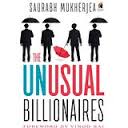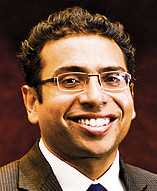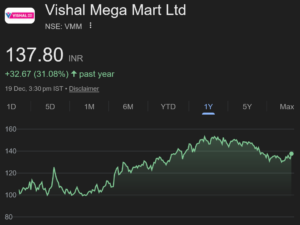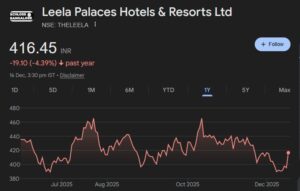
It is well known that novice investors like you and me are not very interested in academic theories relating to investment. The reason for this is because our poverty stricken state forces us to be constantly foraging in the bushes looking for our next meal and leaves us with little time or energy to focus on arcane and esoteric issues.

Saurabh Mukherjea, the whiz-kid with Ambit Capital, knows this fact of life better than anyone else. This is why he follows the salutary practice of keeping us engaged by periodically feeding us with titbits in the form of stock picks whilst simultaneously doling out wisdom relating to investment theory.
In the past, Saurabh has made invaluable stock recommendations such as the “10-bagger portfolio”, the “Coffee Can portfolio”, the “Good and Clean portfolio“, the “storm shelter” stocks and the “islands of safety” stocks. All recommendations were made while drilling sense into us on why buying top-quality stocks pays off in the long run.
Gurus of Chaos
In his debut book “Gurus of Chaos”, Saurabh expanded on that strategy by persuading eminent stock wizards like Sanjoy Bhattacharyya, Akash Prakash, Sankaren Naren, Alroy Lobo, BN Manjunath etc to reveal to us their closely guarded secrets on how to find stocks which have immense multibagger potential.
The Unusual Billionaires
Saurabh has walked the same salutary path in his latest bestseller “The Unusual Billionaires”. His technique is deceptively simplistic in its approach but extremely effective in its implementation.
First, Saurabh has meticulously analyzed the affairs of seven top-quality companies which have made Billions for their promoters and shareholders. These companies are Asian Paints, HDFC Bank, Axis Bank, Marico, Berger Paints, Page Industries and Astral Poly. It is well known that each of the seven companies has been a super-duper multibagger and has created incalculable wealth over the decades.
In particular, Saurabh has identified what characteristics enabled the companies to succeed where their peers could not. He points out that each of the seven companies is a great franchise and that they have attained dominance in the market place owing to innovation, brands, architecture and strategic assets.
He emphasizes that all seven companies fit the criteria of being “good and clean stocks of well-run, sensibly-run companies with believable accounts, credible managements, and good cash generation”.
Second, Saurabh has distilled the common characteristics of the seven companies into a ready-to-use formula. He suggests that a company which fits into the formula can generally be expected to prosper for several years to come and to deliver humongous returns to shareholders.
Third, Saurabh has imparted valuable advice on what our temperament should be to be able to find the winning stocks and hold on to them.
Salient points
All the salient points made by Saurabh in the “The Unusual Billionaires” can be summed up as follows:
Minimum criteria for a stock to be considered investment worthy
In order to qualify for consideration, a stock must satisfy three criteria:
(a) it must have a minimum revenue growth of 10% every year;
(b) It must have a minimum Return on Capital Employed (ROCE) of 15%;
(c) Both, revenue growth and ROCE, must be achieved in a minimum of ten years.
In the case of banking and financial services firms, one has to ensure that the Return on Equity (RoE) is 15% and the loan growth is also 15%, over the past ten years.
Very difficult to find companies that match the 10% revenue and 15% ROCE criteria
Growing a business at a steady pace (10 percent topline growth or better) whilst maintaining healthy levels of profitability (15 percent ROCE or better) over long periods of time is very, very hard. Most people don’t understand how difficult it is to pull this off. As a result companies which are able to achieve this rare feat -18 odd companies out of the 1500 largest companies in India – don’t get the recognition they deserve. That in turn opens up opportunities for the discerning investor who understand how challenging the 10 percent revenue growth plus 15 percent ROCE combination is.
The two filters of 10% revenue growth and 15% ROCE encompass other criteria like dividend payouts & corporate governance
The two filters of 10% revenue growth and 15% ROCE captures two facets of corporate life, namely, the element of growth in the franchise and the moat around the franchise. While revenue growth captures the growth element, the ROCE captures the ability to protect and to guard the franchise. In ROCE, the EBIT (earnings before interest and tax) captures a whole lot of other elements such as cash flow, working capital profitability, which are necessary elements of corporate success. So by combining revenue growth and ROCE all the relevant criteria are factored in. The 10-year period factors in the economic cycle. Over a 10-year period, there is a mixture of recession and boom and the cycle out gets evened out.
As the future is not predictable, look at the past track record and extrapolate it into the future:
As the future is unknowable, there is no point in trying to predict it. Instead, look back as far as possible. Identify companies which have a great track record, and then ask whether given the track record, the track record could be sustained going forward.
The most sensible way to invest is to look back, identify high-class companies and then by applying a process of elimination, knock out a few where there are obvious disruption threats.
Rely on trusted war horses. Don’t trust newcomers
At any point in time, there are barely 30 companies which are investible. It’s a tragedy but it is what it is. With 1,500 companies and Rs 100 crore or more market cap, there are barely 30 companies which are doing a good job of putting more money to work. Therefore, to assume that outside the super set of 30, new challengers will emerge is also a little bit over optimistic. It rarely happens.
The coffee can portfolios which go back 15-16 years show that the names are very similar year after year. The strategy has delivered for 17 years now. If it has worked in the past, there are reasonable grounds for believing it will work in future.
Don’t worry about valuations; buy quality stocks and not ‘cheap’ stocks
If you are short term trader then you should worry out valuations quite a lot. Valuations matter hugely for short term traders. For long term investors, today’s P/E or P/B multiple or tomorrow’s P/E or P/B multiple is of little relevance; their focus is the fundamental quality of the franchise.
For horizons longer than a year valuations do not play a role in generating investment outperformance. Over the long run, the biggest driver of share prices is ROCE followed by revenue growth. There is zero correlation between valuation multiples and share price returns over long run time periods.
In fact, investors who try to buy cheaper stocks almost always end up with lower quality portfolio which generates inferior growth in cash flow and earnings.
Adopt a passive ‘buy and hold’ strategy
Buying high quality stocks and holding them for an extended period of time is a well-known mantra in the world of investing. Several legends including Buffett, Bolton and Peter Lynch have espoused such a strategy. This long term buy-and-hold strategy is boiled down to its very essentials – a simple formula of revenue growth and ROCE to identify high quality stocks – and quantified the market beating investment returns that such a strategy can generate.
Buy and hold strategy is difficult to follow
The ‘buy and hold’ strategy is simple but not easy to follow. First, it requires patience to buy and hold stocks for a decade. Effectively, the investor has to eschew excitement now for returns ten years from now. Secondly, it requires character to hold on to those stocks whose share prices begin to slip in the second, third, fourth or fifth year of the ten year period. Thirdly, it requires a deeper of understanding of what exactly a great company is i.e. great companies are not those who are lionized by the media; they are the anonymous promoters who slog away quietly decade after decade persistently improving their franchises and delivering the 10 percent revenue growth and 15 percent ROCE combination.
Take a ‘portfolio’ approach and don’t obsess over individual stocks
Learn to think of investment in the context of portfolios rather than of stock picks. In a typical portfolio there will be 2-3 star performers who compound at 35 percent or more over ten years, 2-3 dogs who go to zero over ten years and around 8-10 stocks which deliver solid returns of around 15 percent. The average of these 15 stocks will give 20-30 percent per annum compounded over ten years which is significantly better than the 16 percent average return from the Sensex.
Don’t focus on macro factors; focus on the specific fundamentals of the stock
What the markets have shown is that there is absolutely no point in worrying about what the Fed will do, or what the RBI will do, or what this quarter’s results will be. From a fundamental investing perspective there’s actually zero value in it. They main way you make money in any equity market is to buy fundamentally high-quality stocks and hold them for a long period of time. Those are the two central tenets of equity investing success in any era, in any country.
Stock selection is the key to making money. There is no relation between earnings growth and market movements from quarter to quarter. Clean stocks, sensible investing is how investors can make money here, not necessarily by buying the index.
The fundamentally-oriented average retail investor should just focus on the fact that India has a healthy economy, with a core constituency of large long-only investors who keep investing in India, lending support to the market.
New themes and sectors to bet on
For investors who are adventurous and who want to break free of the shackles of the “coffee can” portfolio, Saurabh suggested that the following sectors will do well:
(i) The massive squeeze on black money means that real estate, jewellery and gold investments will suffer and a lot of that money will come into the financial system. This will lead to prosperity of small banks, private sector banks and NBFCs.
(ii) Public sector banks are a strict no-no because they don’t have the money to lend more and private lenders will take over market share;
(iii) There will be an “almost guaranteed death” of the Indian Railways and the migration of freight from rail to road. Roads are a big opportunity. Trucks and truck-financing are big opportunities.
Avoid the airlines sector
The airlines sector faces tremendous challenges. The barriers to entry are modest, and as a result, on a cross cycle basis, it is very difficult to generate a healthy return on capital employed. It is a capital intensive industry. The bigger challenge is to generate a return on that capital. It’s hard because entry barriers are low.
One can see this in India. Because fuel prices are low, airlines are making a bit of money, but as soon as airlines make money, three new players come in and crush profitability for the incumbents and the share prices sag. So it’s a tough sector to invest in.
Avoid commodity and real estate sector
Focus on sectors where cash generation is high. If the company itself is throwing off so much cash it has the resources to compound wealth in the years to come. A professional fund manager might perforce have to have some real estate, steel exposure. However, an average investor has no such compulsion and can maximise returns from it.
Conclusion – Secret formula to finding 10-baggers:
The dominant theme in Saurabh Mukherjea’s book is that investors must identify companies which consistently have the basic techniques of shareholder value maximisation right. If they buy fundamentally high-quality companies and sit tight for a decade, they will effortlessly get compounded returns of around 22-23 percent. This means that they will make 10 times the money in 10 years’ time, is his confident assurance!






Ambit capital 10 bagger portfolio link – http://reports.ambitcapital.com/reports/Ambit_Strategy_Thematic_TenBaggers5_05Jan2016.pdf
Don’t understand the point of this list with 30 stocks. Why not buy a good mutual fund instead?
I really don’t know if this post is real or unreal. But thanks Arjun.
For learning fundamental investing best ever written book for Indian markets is – The Thoughtful Investor by Mr. Basant Maheshwari.
For technical reading of Indian markets best ever place is Uttam Traders.
Mentioning name of those companies which fulfil revenue growth in excess of 10% and ROC in excess of 15% for last 10 years, might have been more fruitful. Will some number savy invester member of this form work on it to mention those names to complete the picture.
criterion for selecting stocks is indeed good, seems like the book can give good insight the basis of investing in stocks.
what i like is not to go for airlines sector since it seems like a fancy
Sir, I am a small investor & searching multibaggars, As per my analysis, Udaipur Cement Works Ltd, can be a multibaggar, some of the features are-
Sector-Cement sector is good for coming 3-4 years,
The Company-
– The company is out of BIFR from Jan2016,
-It is a subsidiary of JK Lakshmi Cement Ltd , group holds 75% equity, after conversion ,equity exceeded 75% which as per SEBI norms to be sold , which was taken by the Morgan Stanley in December 2015.
-Presently doing grinding work for JK Lakshmi cement,
-Clinker manufacturing facility will be started in Nov/Dec 2016 which will increase the margins
-co already in profits with share price of Rs 20 makes it attractive & can be a multi bagger
What is your views ?, can it be a good investment for investors like us?
-S.N.Mishra
need a soft copy of a book by ruchir sharma
NOW THIS YEAR WHO WILL BE NEW BILLIONAIRE
Heavy debt on udaipur cement. D/ e ratio is more than 10. So avoid…